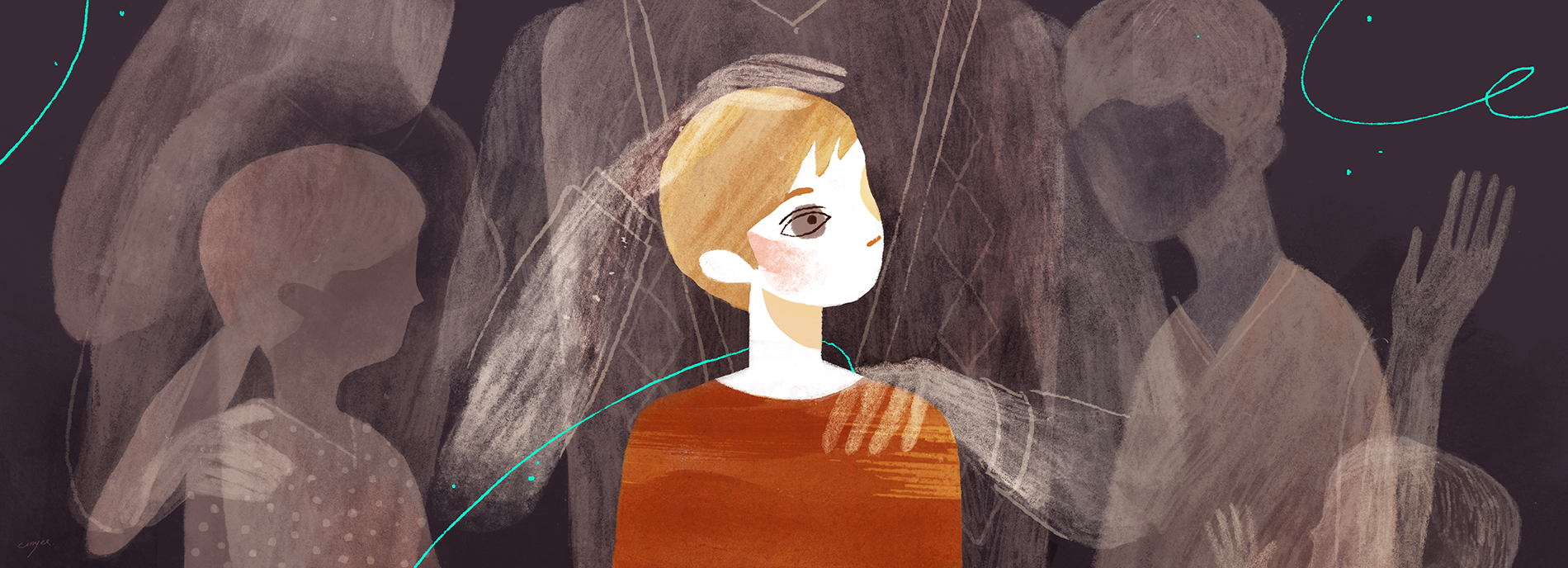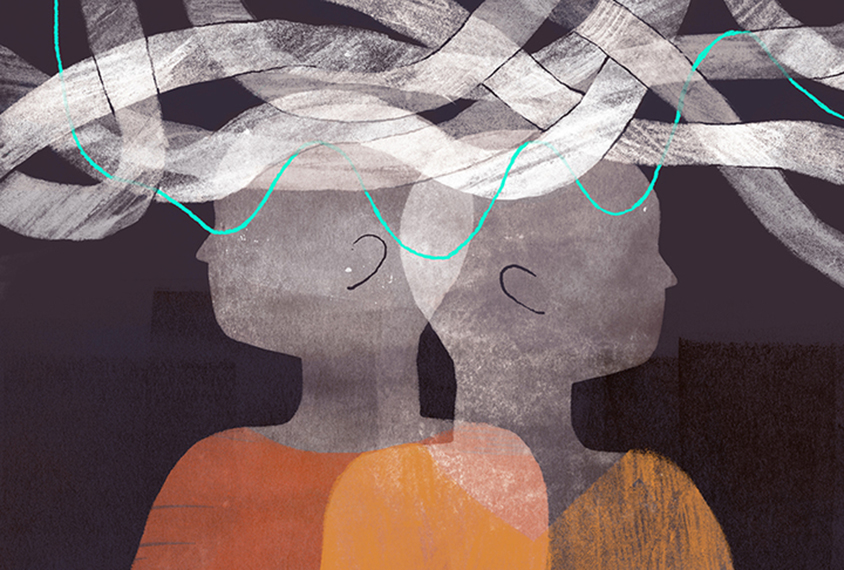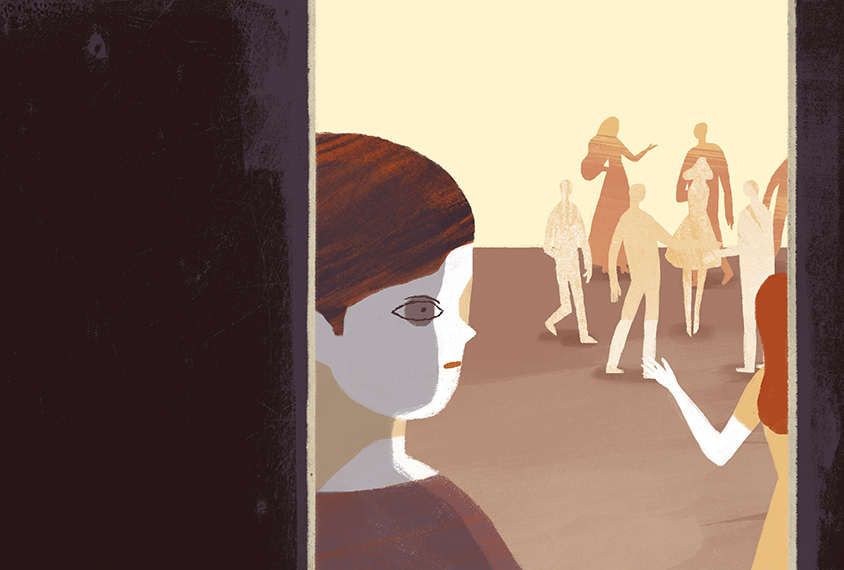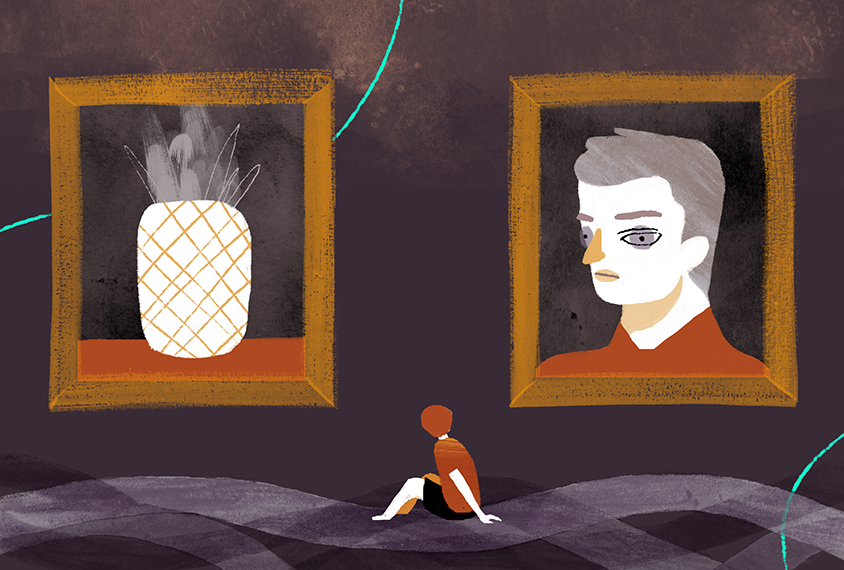
The social ties between autism and schizophrenia
Autism and schizophrenia share a long and tangled history. Comparing the social features of the two conditions could lead to better treatments and a deeper understanding of each.
When the shy, dark-haired boy met with clinicians for a full psychiatric evaluation two years ago, almost everything about him pointed to autism. W. had not spoken his first words until age 2. He was at least 4 before he could form sentences. As he got older, he was unable to make friends. He struggled to accept changes to his routine and maintain eye contact. And despite having an average intelligence quotient, he was unusually attached to objects; at age 11, he still lugged a bag of stuffed animals with him everywhere he went.
But something else was clearly at work, too. “He had these things that he would call day dreams,” recalls Jennifer Foss-Feig, assistant professor of psychiatry at the Icahn School of Medicine at Mount Sinai in New York. When she evaluated W., she noticed that he would often gaze into an empty corner of the room — particularly when he seemed to suspect that she wasn’t paying attention to him. (For privacy reasons, Foss-Feig declined to reveal anything but the child’s first initial.) Occasionally, he would speak to that space, as though someone else were there.
His parents, she recalls, were worried. They explained to Foss-Feig that their son had what he called an “imaginary family.” But W.’s invisible playmates weren’t of the usual harmless variety that many children have; they seemed to be a dangerous distraction both at home and at school. On one occasion, he wandered through a busy parking lot, seemingly oblivious to the oncoming traffic.
As these frightening episodes grew more frequent, they raised a red flag. Doctors had previously attributed the boy’s difficulties to attention deficit hyperactivity disorder and learning disorders. But now it was unclear if those labels really fit. Perhaps, instead of tuning out from the world, W. was unable to distinguish reality from fantasy and had some form of psychosis.
There was no question W. had autism, according to Foss-Feig. She and several of her colleagues were also confident that he was experiencing hallucinations and delusions. Ultimately, they diagnosed him with autism and psychosis, which, Foss-Feig says, was probably due to schizophrenia.

This combination of features, it turns out, is not all that unusual. Studies have found elevated rates of autism among young people with childhood-onset schizophrenia, in which the features of schizophrenia appear before age 13 rather than in late adolescence. And although autism and schizophrenia are characterized differently in popular books and film, scientists have long suspected that the two conditions are somehow linked.
Both conditions are associated with cognitive and sensory-processing problems, both are strongly heritable, and both involve atypical brain development. In terms of social behavior, they can look especially similar. Schizophrenia may be best known for its so-called ‘positive’ features, such as hallucinations and delusions, but it also involves ‘negative’ traits — for example, social withdrawal or a lack of emotional response — that can resemble autism and sometimes lead to misdiagnoses. These social impairments can make it tough for people with either condition to hold a job or make friends.
Scientists are starting to compare the social deficits autism and schizophrenia share, using a variety of methods, from eye tracking and behavioral assessments to electroencephalography (EEG) — a noninvasive way to track the brain’s electrical activity. Some teams hope to expose the conditions’ common neurological roots, whereas others are drilling down into the differences. A definitive picture of the relationship between the two is probably still a long way off. In the meantime, this research may help to explain how social cognition breaks down in each condition — which could lead to more nuanced clinical profiles and better treatments for both.
“What there generally hasn’t been in the literature are very many studies comparing autism and schizophrenia directly,” Foss-Feig says. “That’s what I think we’re moving towards.”
”"When I’m interacting with someone who has autism or somebody who has schizophrenia, it feels like a very different interaction.” Amy Pinkham
‘Social’ profiling:
“You’re just moving in, I’m guessing?” The young man looks the woman opposite him straight in the eye, rocking slightly in his swivel chair. His right thumb absently flips the top of a water bottle back and forth.
“Yes, I am,” she replies.
“I’m your neighbor from across the hall,” he says, still rocking, right thumb still busy.
She smiles broadly and waves her hand. “Oh, hi! Good to meet you.”
At this point, the man looks away. He takes a deep breath and blows the air out slowly, thinking hard about what he might say next. The pause is brief but feels significant. He seems almost relieved when a question tumbles from his mouth: “So … where are you from?”
The two go on to discuss local traffic and movie theaters. After about three minutes, the conversation comes to an abrupt halt.
If the dialogue seems stilted, it’s with good reason: The woman, graduate student Kerrianne Morrison at the University of Texas at Dallas, and the man, who has autism, are role-playing as part of an experiment. The man has above-average intelligence, but there are many tells in his behavior that hint at his diagnosis — his repetitive fiddling with his water bottle is just one example.
Psychologists Noah Sasson and Amy Pinkham, who are conducting the trial, have pored over hours of tape featuring scenes like this one, evaluating how people with autism or schizophrenia approach everyday interactions. They are paying particular attention to things like eye contact and emotion, how much the participants speak, and how frequently they ask questions. The idea, as Sasson puts it, is to take apart massive psychological constructs such as ‘social cognition’ and ‘social dysfunction’ to reveal the “constellation of skills that underlie those big umbrella terms.”
He and Pinkham have a hunch that autism and schizophrenia have vastly different ‘social’ profiles. “From the clinical perspective, when I’m interacting with someone who has autism or somebody who has schizophrenia, it feels like a very different interaction,” Pinkham says. “There’s such a qualitatively different feel to it.”

The husband-and-wife team met in a statistics class in graduate school at the University of North Carolina at Chapel Hill in 2000. Sasson was studying developmental psychology, with a focus on autism, and Pinkham was interested in schizophrenia and clinical psychology. As they got to know each other, both were surprised to learn that in their research, they were asking similar questions, and using similar terminology and tools.
As their work evolved, they expected to uncover even more common ground between their subjects of study — but it didn’t turn out that way.
Other researchers have found that people with autism and those with schizophrenia can both struggle to identify emotions. Sasson and Pinkham’s work hints that different mechanisms could be involved in each group. In a 2007 study, Sasson and his collaborators showed 30 individuals — 10 with autism, 10 with schizophrenia and 10 who are typical — a series of movie stills in which people express fear, anger, sadness, surprise or happiness. Eye tracking revealed that the participants with either condition were less likely than controls to look to the actors’ facial expressions for clues about their feelings. Another study, which Sasson and Pinkham published last year, found that when people with schizophrenia do take note of faces, they are more prone than people with autism or typical people to jump to the wrong conclusions if the expressions are hard to decipher.
In 2012, Pinkham and Sasson evaluated paranoia, a common experience in people with either condition. Again, they saw different mechanisms at work. People with paranoid schizophrenia appear to have an automatic, delusional and omnipresent sense of being under threat. By contrast, those with autism hesitate to engage with or trust other people, a wariness that Pinkham and Sasson suspect is based on negative past experiences. Some research suggests that because people with autism have a limited ability to decipher social cues, they may be more easily victimized or bullied than their typical peers.
Two years later, the team received funding for a larger-scale investigation, evaluating a whole suite of social skills in 54 individuals with schizophrenia, 54 with autism and average intelligence quotients (IQ) and 56 typical adults. Their first study, based on the role-play exercise described above, appeared in January in Autism Research.
When collaborators blind to the participants’ diagnoses evaluated the videos, they consistently ranked people with autism as less socially adept than those with schizophrenia. The researchers also noticed that, compared with the typical adults, those in the other two groups have a harder time keeping a conversation going, but they falter in different ways. People with schizophrenia struggle to maintain eye contact or offer appropriate emotional responses; their facial expressions tend to be impassive, and their voices tend not to carry inflection when they speak.
The participants with autism, on the other hand, are animated but exhibit a distinct lack of social reciprocity: They do not ask their conversation partners many questions and instead tend to deliver monologues about their own personal interests. Sasson and Pinkham also observed that a higher IQ predicts better social skills among people with schizophrenia but not among those with autism.
Taken together, the findings suggest that people with autism and those with schizophrenia are trying to surmount fundamentally different challenges when they attempt to socialize. Those with autism appear less interested in getting to know others and so do not engage them in balanced, mutual exchanges. By contrast, individuals with schizophrenia seem motivated to interact but don’t express themselves well enough nonverbally to forge strong connections.
Entwined diagnoses:
For too long, psychology has mistakenly relied on the same language to describe similar features in autism and schizophrenia. Sasson and Pinkham hope that their profiling work will build up a new vocabulary to help disentangle the two conditions.
The roots go deep. In the early 20th century, autism was — by its very definition — tied to schizophrenia. Swiss psychiatrist Paul Eugen Bleuler coined the term ‘autism’ to describe a key feature of schizophrenia. Specifically, Bleuler used ‘autism’ to describe how people with schizophrenia tend to disengage from the outside world.
It was not until 1943 that an American child psychologist, Leo Kanner, reclaimed the word for the range of traits we know today as autism. Kanner borrowed Bleuler’s term to describe 11 children who were socially detached, more interested in objects than in people, and who exhibited rigid, repetitive behaviors and communication difficulties.
Kanner recognized that autism was more than just a schizophrenic trait, but he struggled to draw further distinctions. In the 1970s, though, genetic and epidemiological research homed in on a few big differences. For example, some studies revealed that families are generally prone to either autism or schizophrenia, but not both. Child psychiatrist Israel Kolvin noticed that hallucinations rarely arose in ‘psychotic’ children whose features emerged before age 3. Instead, these toddlers more often developed language delays and poor social relationships.
The two diagnoses started to take on separate lives, with age of diagnosis — around 4 years in autism and between 16 and 30 in schizophrenia — becoming an important differentiator. By 1980, the “Diagnostic and Statistical Manual of Mental Disorders” (DSM) listed autism and schizophrenia as distinct diagnoses. According to that edition of the DSM, there was no overlap: Autism and schizophrenia could not co-occur.
The question remained settled until the 1990s, when more sophisticated analyses reopened it. In the past two decades, a growing number of studies have produced a wealth of complex, sometimes contradictory, evidence. Some implicate developmental problems, such as faulty pruning of the connections between neurons, in both schizophrenia and autism. Clinical findings also indicate that having any psychotic disorder, including schizophrenia, comes with an above-average risk for having autism as well.
At the same time, some genetic studies counter the notion that autism and schizophrenia share a fundamental connection. When molecular biologists scoured common genetic variants — changes to a single base in the DNA — that contribute to these conditions in the hopes of finding shared risk factors, their search came up short.
In other research, involving rare, large mutations, the conditions appear to be opposites: Extra copies of DNA along the same region of chromosome 22, for example, increase the risk for autism but protect against psychosis. A study published in May found that this duplication (or absence) of genetic material relates to a distinctly different brain structure, such as a larger or smaller corpus callosum, the tract of white matter connecting the brain’s hemispheres. Additional work suggests that shared genetic and environmental risks — for instance, prenatal infections — are ‘nonspecific.’ In other words, they increase the odds of developing any number of neurodevelopmental conditions, not just autism and schizophrenia.
How to reconcile these results? Researchers point to the fact that autism and schizophrenia are both highly variable — no two individuals have the same constellation of traits. For this reason, the labels ‘autism’ and ‘schizophrenia’ could include a range of subtypes or conditions within them. Perhaps some of these smaller groups overlap, whereas others do not.
But bringing autism and schizophrenia back together — at least in a research setting — could generate new leads for characterizing and addressing both. “I think for a long time there was a hesitancy to do this kind of work,” Sasson says, “because of the tortured history of separating the two conditions.”
”“Saying a person has autism or has schizophrenia doesn’t really tell us too much about how to help them.” James McPartland
Features first:
Just about 70 miles north of Foss-Feig’s office in New York City is the lab of autism researcher James McPartland, at the Yale Child Study Center. He served as her postdoctoral mentor and, like Foss-Feig, says autism researchers can learn a lot by studying people with psychosis.
“Saying a person has autism or has schizophrenia doesn’t really tell us too much about how to help them,” says McPartland. Instead, it’s important to recognize an individual’s specific strengths and weaknesses, he says.
McPartland is part of a small but growing cadre of investigators interested in developing the Research Domain Criteria (RDoC), a new classification system for conditions affecting the brain. Proposed in 2010 by Thomas Insel, former director of the National Institute of Mental Health, the RDoC aims to go beyond the DSM’s lists of behavioral symptoms and diagnostic categories. Its proponents want scientists to consider mental health in terms of functional ‘dimensions,’ such as social processes or cognition, rather than by diagnostic labels.
As part of that initiative, McPartland is leading one of the largest comparative studies of social ability in autism and schizophrenia. To date, he has gathered data from 142 individuals with autism or schizophrenia, as well as controls. Among other things, he is comparing how these three groups recognize and read faces. The participants view faces, conveying various emotional expressions, on a monitor in the lab. At the same time, the researchers track changes in the brain using EEG.
In a typical individual, the EEG records a spike in electrical activity about 170 milliseconds after she sees a face — which previous studies have found corresponds to the moment of recognizing a face over some other kind of object. This so-called ‘event-related potential,’ dubbed N170 for short, is also associated with registering emotions. Looking at a fearful face, for instance, yields a bigger spike at the 170-millisecond mark than looking at a neutral expression.

But this pattern of activity looks different in people with autism. In 2004, McPartland’s group found that the early face recognition is delayed in people on the spectrum. Meanwhile, other research teams have reported a smaller-than-usual spike at N170 in people with schizophrenia. McPartland says these atypical variations could be important. In people with schizophrenia, for example, the ability to perceive another person’s emotional state can accurately predict social functioning more broadly. Unusual brain activity associated with facial recognition might also serve as a biological clue, or biomarker, to predict interpersonal abilities in autism.
“There are lots of things that are potentially informative biomarkers for autism that have been studied very thoroughly in schizophrenia,” McPartland says. Even though a biomarker shared by schizophrenia and autism might not reveal anything specific to autism, he adds, it might highlight a neural process that is central to social cognition, and that might be altered in several conditions, including autism.
This idea of finding shared neural processes presupposes that the same problems explain the social difficulties seen in people with autism and those with schizophrenia — an idea that Sasson and Pinkham’s work has brought into question. But McPartland doesn’t see any conflict.
“I think our findings actually concord with them,” he says. “In certain contexts, I think it makes more sense to draw lines, and in certain contexts its helpful to treat things as continua.” Whereas behavioral findings may call for discrete categories, he says, the brain data may fall on a continuum.
In autism, for example, his preliminary work suggests that there are more pronounced differences in brain processing involved in distinguishing faces from objects; in schizophrenia, there are greater differences related to decoding emotions. “But it doesn’t have to be one or the other,” he adds. “All of these things may be impacted to different degrees across diagnostic categories.”
Tailoring treatment:
Perhaps the most valuable takeaway from comparing autism and schizophrenia’s social features would be better treatment. When it comes to interventions designed to bolster social skills, “adults with autism have almost no treatment options currently,” observes Shaun Eack, professor of social work and psychiatry at the University of Pittsburgh.
That’s not true for schizophrenia. Eack is trying to work ‘trans-diagnostically’ to adapt an existing therapy for adults with schizophrenia to help those with autism.
For more than a decade, Eack and his colleagues have studied cognitive enhancement therapy, designed to bolster social thinking. Unlike most treatments for schizophrenia — such as medication to subdue delusions — this program was designed to address the condition’s ‘negative’ traits, those that most resemble autism. It combines computer exercises to boost problem-solving and memory with structured group sessions, in which participants practice social skills, such as reading nonverbal cues and taking someone else’s perspective.
Eack has found that the program helps some people with schizophrenia find and keep satisfying employment. In light of such success, Nancy Minshew, his colleague at the University of Pittsburgh, approached him with a question: Might it also benefit people with autism?
In 2013, his team tested memory, problem-solving, attention, processing speed and emotion processing — the same abilities cognitive enhancement therapy treats — in 43 people with autism, 47 with schizophrenia and 24 neurotypical volunteers. They found that people with either condition are similarly impaired in these aspects, suggesting that cognitive enhancement therapy could work for autism.
But newer results published in March indicate that it may need serious modification first. Eack, Minshew and their colleagues asked people with either schizophrenia or autism to imagine someone else’s visual perspective. Both groups struggled, as expected, but magnetic resonance imaging revealed different underlying brain activity. Low performance in schizophrenia is linked to a lack of communication between the frontal and temporal regions, which become active during perspective-taking. In autism, poor scores correlate with an overabundance of neural chatter within the prefrontal region, associated with cognition and decision-making.
Looking at these results, along with Pinkham and Sasson’s findings, Eack says, “There may be certain things that are particularly prominent to focus on in schizophrenia — and other things that may be less prominent or more prominent to focus on in autism. The big question, though, is: What is that?”
Eack says he doesn’t believe we have enough information yet to answer the question. For the moment, he says, “all we’re getting are little inklings.”
Eventually, though, the kind of work Eack is doing might allow clinicians to tailor treatments to individuals. It’s an approach that Foss-Feig says would help with hard-to-classify children, such as W., the quiet 11-year-old. For that boy, her colleagues recommended medication commonly prescribed for schizophrenia and behavioral therapy used to treat autism, along with guidance on both conditions for his parents and teachers.
Meeting him spurred Foss-Feig’s own interest in studying the intersection of autism and schizophrenia. “We can call it autism if it’s helpful to call it autism,” she says. “Or we could call it a combination of echolalia [repeated speech], which is treated with this, and lack of social motivation, which is treated with this … and so forth.”
With that sort of an approach, Foss-Feig might have designed a treatment program to target W.’s unique challenges, instead of worrying first about whether he has autism, schizophrenia or both.
Syndication
This article was republished in Scientific American.
Recommended reading

New organoid atlas unveils four neurodevelopmental signatures

Glutamate receptors, mRNA transcripts and SYNGAP1; and more

Among brain changes studied in autism, spotlight shifts to subcortex
Explore more from The Transmitter

Psychedelics research in rodents has a behavior problem
Can neuroscientists decode memories solely from a map of synaptic connections?
